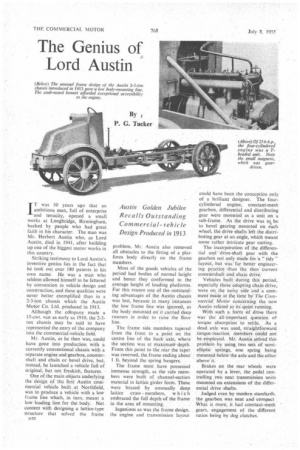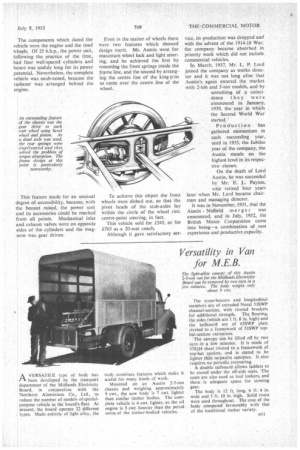The Genius of Lord Austin
Page 56

Page 57

If you've noticed an error in this article please click here to report it so we can fix it.
By • P. G. Tucker
Austin Golden Jubilee Recalls Outstanding Commercial-vehicle Design Produced in 1913 IT was 50 years ago that an ambitious man, full of enterprise and tenacity, opened a small works at Longbridge, Birmingham, backed by people who had great faith in his character. The man was Mr. Herbert Austin who, as Lord Austin, died in 1941, after building up one of the biggest motor works in this country_
Striking testimony to Lord Austin's inventive genius lies in the fact that he took out over 180 patents in his own name. He was a man who seldom allowed himself to be fettered by convention in vehicle design and construction, and these qualities were never better exemplified than in a 2-3-ton chassis which the Austin Motor Co. Ltd. produced in 1913.
Although the cchrmany made a 15-cwt. van as early as 1910, the 2-3ton chassis may be said to have represented the entry of the company into the commercial-vehicle field.
Mr. Austin, as he then was, could have gone into production with a currently conventional chassis with a separate engine and gearbox, countershaft and chain or bevel drive, but, instead, he launched a vehicle full of original, but not freakish, features. One of the main objects underlying the design of the first Austin commercial vehicle built at Northfield, was to produce a vehicle with a low frame line which, in turn, meant a low loading line for the body. Not content with designing a lattice-type structure that solved the frame
ot 0
problem, Mr. Austin also removed all obstacles to the fitting of a platform body directly on the frame members.
Most of the goods vehicles of the period had bodies of normal height and hence they conformed to the average height of loading platforms. For this reason one of the outstanding advantages of the Austin chassis was lost, because in many instances the low frame line was ignored, as the body mounted od. it carried deep runners in order to raise the floor The frame side members tapered from the front to a point on the centre line of the back axle, where the section was at maximumdepth. From this point to the rear the taper was reversed, the frame ending about 1 ft. beyond the spring hangers.
The frame must have possessed immense strength, as the side members were built of channel-section material in lattice girder form. These were braced by unusually deep lattice cross members, which embraced the full depth of the frame in the area of mounting.
Ingenious as was the frame design. the engine and transmission layout could have been the conception only of a brilliant designer. The fourcylindered engine, constant-mesh gearbox, differential and distributing gear were mounted as a unit on a sub-frame. As the drive was to be to bevel gearing mounted on each wheel, the drive shafts left the distributing gear at an angle, which meant some rather intricate gear cutting.
The incorporation of the differential and drive-shaft gear with the gearbox not only made for it " tidy " layout, but was far better engineering practice than the then current countershaft and, chain drive.
Vehicles built during this period, especially those adopting chain drive, were on the noisy side and .a comment made at the time by The Comineti.ial. Motor concerning the new
Austin related to quiet running.
With such a form of drive there• was the all-important question of torque absorption to settle. As a dead axle was used, straightforward torque-reaction members could not be employed. Mr. Austin solved this problem by using two sets of semielliptic springs, one spring being mounted below the axle and the other above' it.
Brakes on the rear wheels were operated by a lever, the pedal controlling two neat transmission units mounted on extensions of the differential drive shafts.
Judged even by modern standards, the gearbox was neat and compact What is more, it had constant-mesh gears, engagement of the different ratios being by dog clutches. The components which dated the vehicle were the engine and the road wheels. Of 25 b.h.p., the power unit, following the practice of the time, had four well-spaced cylinders and hence was unduly long for its power potential. Nevertheless, the complete vehicle was snub-nosed, because the radiator was arranged behind the engine.
This feature made for an unusual degree of accessibility, because, with the bonnet raised, the power unit and its accessories could be reached from all points. Mechanical inlet and exhaust valves were on opposite sides of the cylinders and the magneto was gear driven.
Even in the matter of wheels there were two features which showed design merit. Mr. Austin went for maximum wheel lock and light steering, and he achieved the first by mounting the front springs inside the frame line, and the second by arranging the centre line of the king-p:ns to come over the centre line of the wheel.
To achieve this object the front wheels were dished out, so that the pivot heads of the stub-axles lay within the circle of the wheel rim: centre-point steering, in fact.
This vehicle sold for £545, or for £765 as a 20-seat coach.
Although it gave satisfactory ser
vice, its production was dropped and with the advent of the 1914-18 War. the company became absorbed in priority work which did not include commercial vehicles.
In March, 1937, Mr. L. P. Lord joined the company as works director and it was not long after that Austin's again entered the market with 2-ton and 5-ton models, and by something of a coincidence they were announced in January, 1939, the year in which the Second World War started. '
Production has gathered momentum in each succeeding year, until in 1955, the Jubilee year of the company, the Austin stands on the highest level in its respective classes.
On the death of Lord Austin, he was succeeded by Mr. E. L. Payton, who retired four years later when Mr. Lord became chairman and managing director.
It was in November, 1951, that the Austin Maleld merger was announced, and in July, 1952, the British Motor Corporation came into being—a combination of vast experience and productive capacity.




















































































































